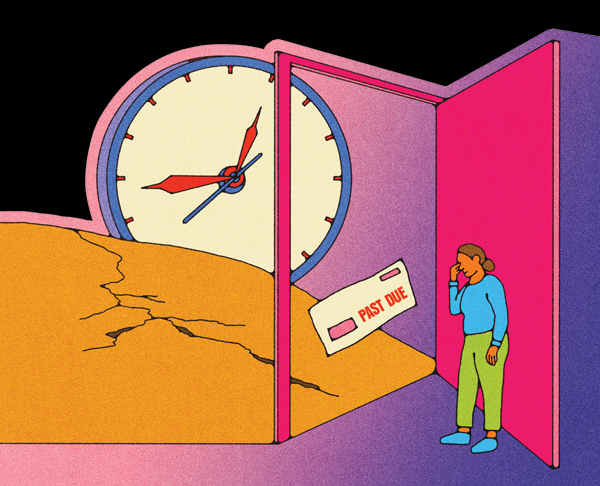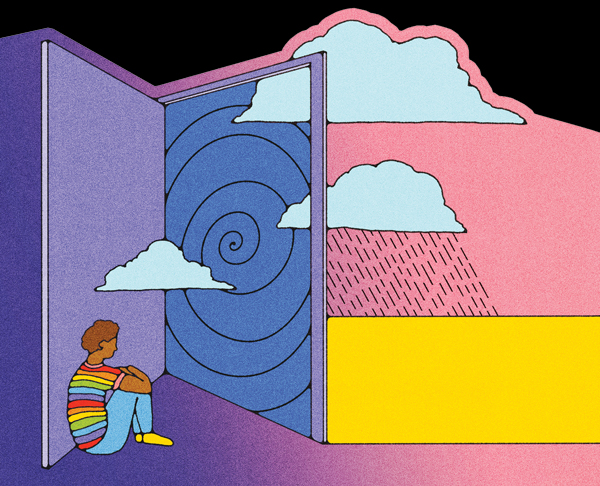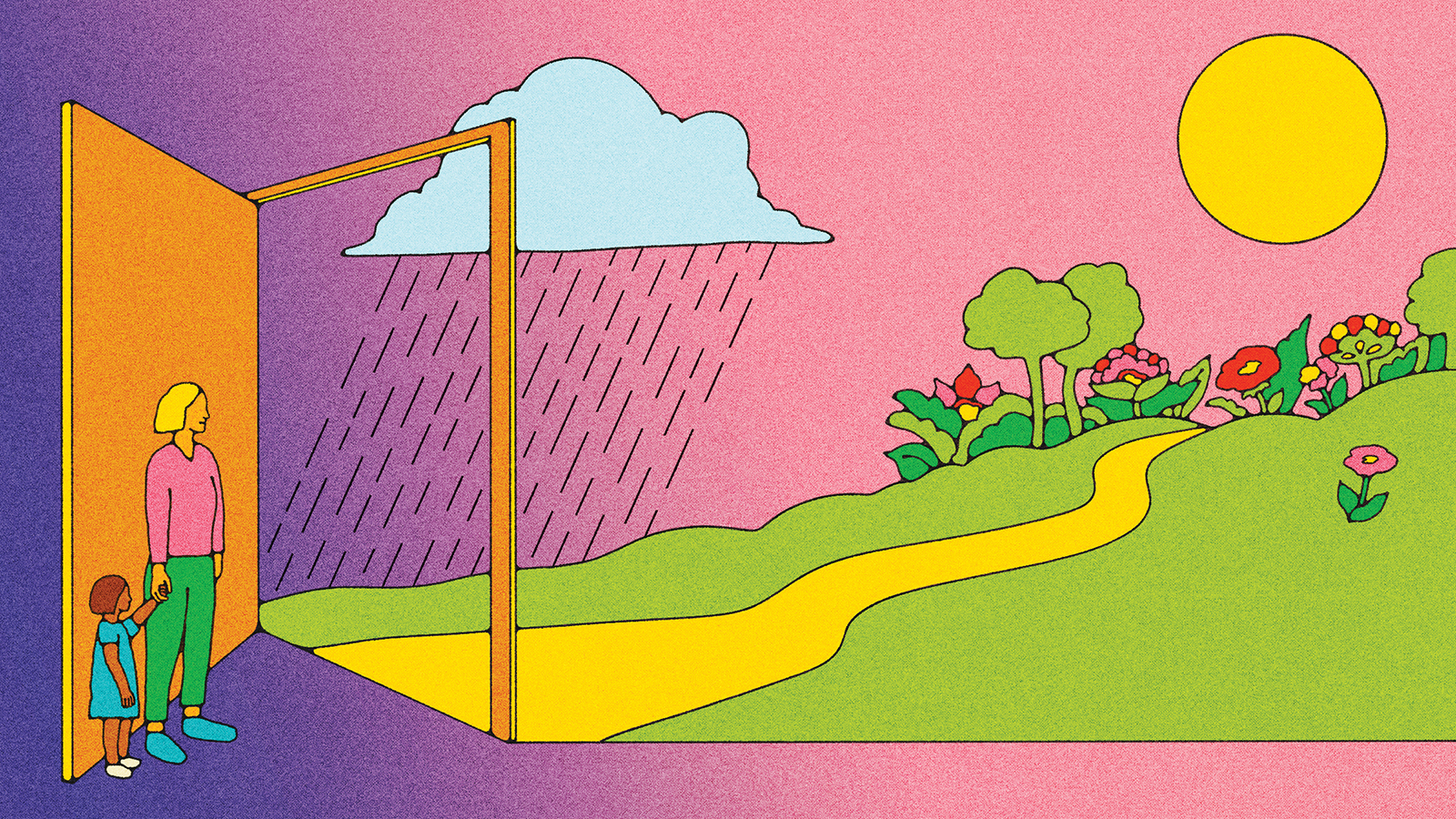By Michael Blanding
Illustrations by Kate Dehler
When the COVID-19 pandemic first hit in the spring of 2020, it was a phenomenon unlike any the modern world had seen. “The fact that a virus can seemingly come out of nowhere, float in the air and put your life or the lives of your family and community at risk is an existential kind of dread many Americans had never faced before to this magnitude,” says Jonathan Metzl, the Frederick B. Rentschler II Professor of Sociology and Psychiatry and chair of the Department of Medicine, Health and Society.
As the pandemic endured and the death toll continued to rise, the initial uncertainty about the virus turned into something else—a glaring mental health crisis that has taxed the ability of our country’s medical system to manage it. “The pandemic has done two things. It created an unbelievable amount of anxiety and despair in and of itself, and it also highlighted the urgent need for more mental health treatment,” Metzl says. “Unfortunately, we’re going in the opposite direction—a perfect storm of a faulty existing structure and massive levels of current stressors.”
A review by Boston University School of Public Health researchers, published in The Lancet, found that rates of depression in the United States tripled from 9 percent to 29 percent during the early months of the pandemic and then continued to rise to 33 percent—affecting one in three Americans—by 2021. Another study by the University of Alabama at Birmingham found symptoms of depression and anxiety rose from 11 percent to 40 percent between April 2020 and April 2021, with higher rates among people who identify as Black, Hispanic/Latinx and Asian.
The stressors the country faces go beyond the pandemic. Within the past three years, long-simmering tensions over racial injustice have erupted in the wake of George Floyd’s murder and other instances of police brutality, while political divisions have deepened seemingly beyond repair—as evidenced by the insurrection at the U.S. Capitol in 2021. Economic disruptions from the pandemic and the Russian invasion of Ukraine have created financial uncertainty; headlines are filled with stories of deadly school shootings such as the recent massacre in Uvalde, Texas; and culture wars over abortion and sexual identity have created new anxieties for women and LGBTQ youth. Casting a shadow over it all is the growing threat of climate change as extreme droughts, floods and other weather-related disasters become more commonplace.
Psychologists and psychiatrists have sometimes struggled to keep up with the multiplying mental health challenges posed by these developments. Yet, research at Vanderbilt University offers a potential way out of this dark chapter in the nation’s history. Through studies and interventions, Vanderbilt faculty members are providing new insights into the crisis—as well as the best evidence-based solutions for overcoming it.

Understanding Stressors
“In psychology, for ethical reasons, we are limited in the type of stressors we can model in the laboratory,” says Bunmi Olatunji, Gertrude Conaway Vanderbilt Professor of Psychology and director of clinical training in the Department of Psychology. “But the pandemic has really become a naturalistic laboratory of sorts for researchers to better understand the effects on individuals who have risk factors already.”
The doubts that the pandemic and other social disruptions have created make a breeding ground for anxiety, Olatunji says. “The pandemic creates an environment of uncertainty: ‘How long is this going to last? What’s the next strain? What’s this monkeypox thing all about?’ And it’s not alone in that regard. The political climate does that, gun violence does that. And once you have uncertainty, oftentimes the way individuals deal with that is to worry.” In cases of anxiety, that worry becomes debilitating, causing people to either overreact to stimuli or to freeze and become paralyzed.
Olatunji’s lab has been looking into the emotional roots of that anxiety. Traditionally, researchers have attributed anxiety to fear, but even before the pandemic, Olatunji was demonstrating the impact of another emotion: disgust. Over years of analysis, he and colleagues have been able to show that a feeling of disgust is highly correlated with anxiety and obsessive-compulsive disorders. When COVID-19 hit, his lab found that those with a high propensity for disgust were much more likely to engage in safety-related behaviors, such as wearing a mask, and also to experience an increase in levels of anxiety due to the pandemic.
“From an evolutionary standpoint, disgust is actually an adaptive emotional response that helps us to avoid disease,” he explains. While some of that avoidance may be helpful, he says, in some individuals it becomes debilitating.
“The issue is whether we can identify the tipping point where safety behaviors are no longer offering the desired return,” adds Olatunji, who uses assessment tools to help identify when reasonable worry turns into a crippling disorder. “You want to engage in safety behaviors during COVID, but you also want to be able to go to the grocery store to get something if you need it.”
The pandemic has really become a naturalistic laboratory of sorts for researchers to better understand the effects on individuals who have risk factors already.
Other Vanderbilt researchers have used the pandemic as a natural laboratory to study mental health disorders. Autumn Kujawa, assistant professor of psychology and human development and director of the Mood, Emotion and Development Lab, has focused her research on adolescents, a particularly vulnerable group. Starting early in March 2020, her lab developed a questionnaire to measure the effects of stress on teens and young adults. Not surprisingly, she says, “we found a dramatic increase in depression right around the start of the pandemic.”
The issues were not without their nuances, however. Some types of anxiety, such as social anxiety, actually decreased during the pandemic. “It made sense because a lot of the social pressures of school and peers and bullying were taken off,” she says. Over time, however, the lack of social connections likely exacerbated anxiety and depression by creating isolation among teens separated from daily interactions with peers.
Meanwhile, Kirsty Clark, assistant professor of medicine, health and society, has been researching the risks and protective factors for the mental health of LGBTQ youth. In particular, she has examined the effects of different kinds of stigma—whether from family, peers or society as a whole—on anxiety, depression and suicidal thoughts among these young people. Pandemic or no, LGBTQ youth already experience concerning levels of mental health issues—with 73 percent reporting symptoms of anxiety and 58 percent reporting symptoms of depression, according to the The Trevor Project’s 2022 National Survey on LGBTQ Youth Mental Health.
In reviewing large data sets, Clark has determined that various forms of stigma increase anxiety, depression and suicidality among LGBTQ youth, starting as young as age 9 and becoming cemented by age 12. In a recent study, she used death records from the National Violent Death Reporting System to look at instances of youth suicide in the United States. Along with colleagues from Yale and UCLA, Clark was able to identify LGBTQ youth and use narratives from nearly 10,000 death records to identify whether the youth had been bullied—and whether the bullying may have led to the suicide. They found that “not only is bullying associated with suicidal thoughts among this group, but this study actually showed bullying can be a precursor to suicide mortality for LGBTQ young folks,” Clark says.
“It really highlights the need for universal anti-bullying interventions in schools, but especially those interventions that specifically speak to the needs of LGBTQ youth.”

Finding Solutions
Despite the emotional devastation of the past few years, psychologists have found solutions that can help individuals cope and overcome the effects. Steven Hollon, Gertrude Conaway Vanderbilt Professor of Psychology, has spent the past 40 years examining the prevention and treatment of depression. While depression is often seen solely as a disorder, Hollon has viewed it increasingly from the perspective of evolutionary biology as an adaptive mechanism that people use to contemplate and make sense of loss or trauma.
“If you have a complex and interpersonal problem to solve, you better think about it very deeply,” he says. “The energy goes to the brain and makes you ruminate.”
Before the pandemic, national surveys found that about 15 percent of people on average will experience major depression at some point—20 percent of women and 10 percent of men—and often they get over it, whether or not they receive help. In some instances, however, the problem can become chronic.
“One of the ways you can get stuck in depression is to start blaming yourself and seeing it as a flaw in your character,” Hollon says. Much of his research involves comparing medication with psychological treatments such as cognitive behavioral therapy to help address those negative thoughts.
One of the ways you can get stuck in depression is to start blaming yourself and seeing it as a flaw in your character.
Hollon describes CBT as “running experiments on your own brain” by trying to more accurately assess situations that might cause depression, trying new behaviors and examining the results. Studies by Hollon and others have shown that CBT and antidepressant medications have about the same efficacy in treating depression, and medications have the advantages that “they are fast and they don’t depend on the skill of the therapist,” he says. On the other hand, medications can have some side effects, including upset stomach, headaches, sleeping problems and erectile dysfunction.
More crucially, Hollon says, CBT has longer-lasting effects than medication. “Folks who have gotten better on cognitive therapy are less likely to have depression come back—they learn to deal with things,” he says.
CBT is also the best treatment for anxiety disorder, says Bunmi, who believes there is value in using it proactively as a preventative measure. “Once you start identifying the thoughts and beliefs people are attaching to their environment,” he says, “you can educate people about more adaptive thinking styles and teach them to be more accurate in their thought processes.”
In her research on adolescents, Kujawa has found similar results about the power of training thoughts. In hopes of better predicting who is at risk for anxiety and depression, her lab has begun running experiments using electroencephalograms (EEGs). Participants are shown images known to elicit a negative emotional reaction—such as a violent dog or grieving people—while EEGs monitor their brain activity noninvasively.
“In some situations, we ask them to just view them naturally, and other times we ask them to try and reduce their emotional responses by thinking about the image in a different way,” she says.
She found that those adolescents who were better able to reduce their emotional responses, as measured by EEG, also showed less of an increase in depressive symptoms during the pandemic. Such techniques could be used to identify teens who are more at risk for mental health problems before a stressor occurs and to teach them coping skills to prevent the emergence of symptoms.
The ability to reframe and think differently about issues can be helpful for teens dealing with the anxiety about school shootings, which are increasingly in the news. Many teens, Kujawa says, have developed anxieties about being in large, public spaces due to fears of shootings. In part, she says, that’s due to adolescents having less ability to think in probabilities—the actual chances of a shooting happening in any particular place. While not invalidating their fears, doctors and parents can help them put the issue into perspective.
“It’s related to this idea of reappraisal and changing the way teens are thinking about it,” Kujawa says. “Yes, this is really scary, but what are the statistics, what is the likelihood it could happen?”
For LGBTQ youth, specialized forms of treatment are needed to address their particular challenges. Based on the fact that the strongest predictor of thriving for LGBTQ youth is a supportive family environment, Clark is working to develop interventions for families who may be less supportive of their child’s sexual orientation or gender identity. Working with the Oasis Center, a Nashville nonprofit, Clark and colleagues at Vanderbilt University Medical Center are collaborating to target
family-based interventions for LGBTQ youth who have been hospitalized at VUMC after a suicide attempt or other trauma. It’s a point where clinicians may find parents available and more receptive to support.
“We can really access those parents,” she explains, “and say, ‘We know this has been a difficult journey. How can we meet you where you are … and provide you the resources to support your child?’”

Changing the System
As effective as these interventions may be, Vanderbilt faculty also stress the need to fix the mental health care system as a whole. “We’ve been able to avoid addressing the mental health crisis in this country for a long time,” Metzl says, “and now it’s simply unavoidable.”
Fixing the system will require more funding, but that isn’t the only concern, he says. In researching his book Dying of Whiteness: How the Politics of Racial Resentment Is Killing America’s Heartland (Basic Books, 2019), Metzl noticed a frustrating phenomenon: While lowering taxes for the wealthy and stoking resentment against immigrants and minorities, some politicians at the same time resisted Medicaid expansion in Tennessee that would have directly helped poor white constituents.
“A lot of people were being told that their problems were the results of immigrants pouring over the border, or minorities taking jobs or other resources,” Metzl says, “but if a state like Tennessee had adopted parts of the Affordable Care Act that expanded Medicaid, there would have been health care for many, many more people. There are actually plenty of resources in the system to go around, but they were just making a political decision not to allocate them in ways that help people.”
The upshot has been poor mental health infrastructure that has led to increases in opioid addiction and suicide by firearms, among other negative consequences. In addition to more funding, Metzl advocates a rethinking of health infrastructure that would make the system more accessible to the average person. One possibility, he says, is increasing community-based health care centers that can provide one-stop shopping for therapy and outreach to local schools and employers.
“The pandemic has challenged us to think in much more creative terms about mental illness and how we deliver treatment in a way that’s beyond just the biomedical model,” Metzl says.
Even within the medical model, changes could be made to steer patients to more effective treatments such as CBT. “Despite the fact that we have decent evidence-based treatments, many people don’t really have access to them,” Olatunji says. Part of the problem, he explains, is the lack of people trained in these techniques, as well as the cost for patients and the fact that the treatments are not always covered by insurance. Even with insurance coverage, patients often endure long waiting lists to see practitioners, especially given the current demand for mental health treatment.
The pandemic has challenged us to think in much more creative terms about mental illness and how we deliver treatment in a way that’s beyond just the biomedical model.
For adolescents, Kujawa says, the key is making it easier to coordinate all the different areas of teens’ lives. “It’s just too hard for parents to navigate the mental health system,” she says. “There needs to be a better system in place for more connections between school and family and health providers in terms of making sure everyone is keeping an eye out for kids and helping them to get the services that they need.”
Those supports are even more crucial for LGBTQ youth, Clark says; studies have shown that those youth report lower symptoms of depression and anxiety when attending schools that have a gender-sexuality alliance group, making it particularly problematic when legislation attempts to prohibit discussion of LGBTQ identities in schools, as with “Don’t Say Gay” bills. “That type of legislation chills the ability to have schools be a safe space,” she says.
Above all, Hollon says, doctors should resist the urge to immediately prescribe medication to deal with anxiety and depression, especially without other supports. Training in CBT is slowly becoming more common among doctors, nurses and nurse practitioners, and even in the absence of in-house treatment, doctors can refer patients to therapists who practice the technique or the growing number of CBT apps that are becoming increasingly effective. Also, more health care providers are offering access to CBT through telehealth appointments.
“Primary-care physicians are doing their best,” he says, “but we need to have all the professions working together.”
Even with such a coordinated effort and better policies in place, Vanderbilt researchers say the mental health crisis in the U.S. is likely to persist for the foreseeable future. Many of the stressors fueling the crisis, including climate change, political division, gun violence and more, show no signs of abating, and the pandemic itself is stubbornly holding on, with new coronavirus variants continuing to emerge.
And yet, if there’s a bright spot, Vanderbilt researchers add, it’s that there’s an opportunity to, at the very least, change the trajectory of the crisis. By learning to identify and treat anxiety and depression early on, society can better cope with the challenges. Much depends on improved access, training and resources across the health care system as a whole, but it’s also incumbent on individuals to seek the help they need. As Hollon notes, the path forward begins with the smallest of steps.
“The two things I say are: ‘Don’t wait for motivation to come. Get started and the motivation will follow,’ and ‘Don’t believe everything you think,’” he says. “When people walk out of treatment having incorporated those two things, they are less likely to get thrown for a loop the next time a bad thing happens.”
